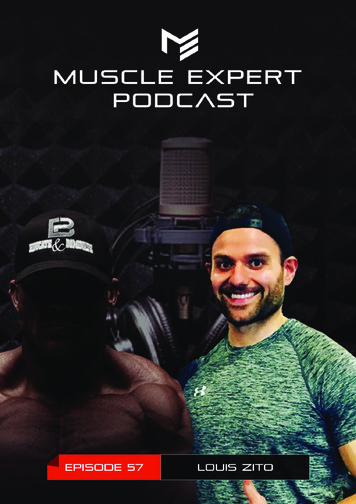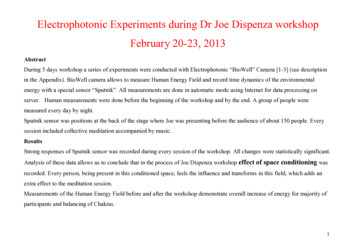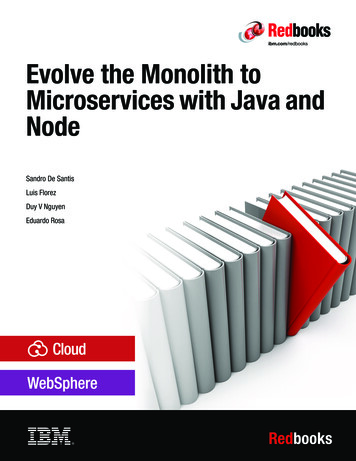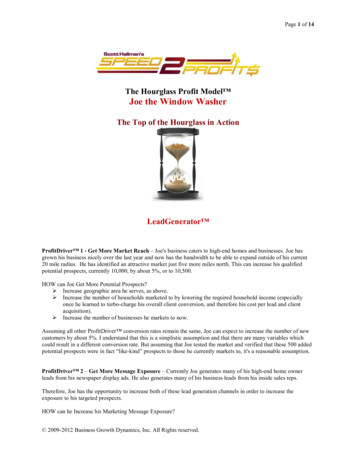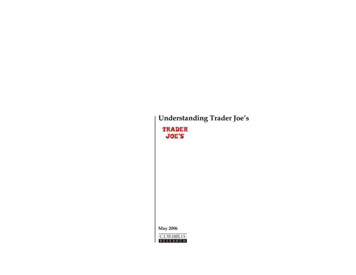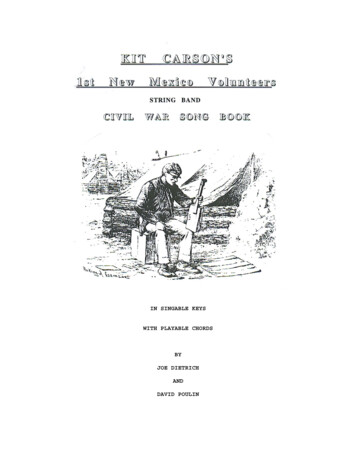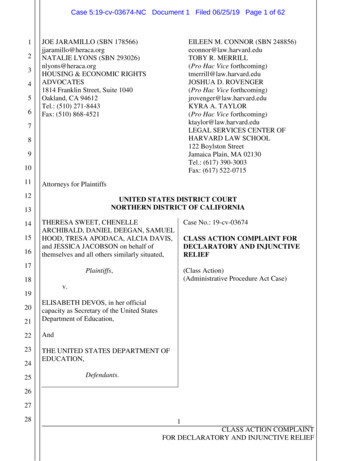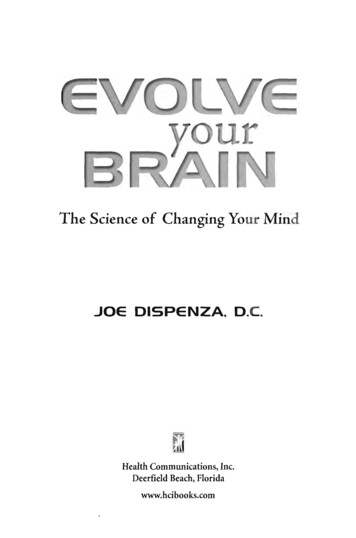
Transcription
The Science of Changing Your MindJOE DISPENZA, D.C.Health Communications, Inc.Deerfield Beach, Floridawww.hcibooks.com
The content of this book is published for educational and informational purposesonly. The content of this book should not be used for the diagnosis or treatment ofany condition or disease. The case histories presented are provided for illustrativepurposes only. No express or implied guarantee of results is made. If you are currently being treated by a physician or other healthcare practitioner for any conditionor disease, consult with that provider prior to changing or modifying any treatmentprogram.Library of Congress Cataloging-in-Publication Datais available through the Library of Congress. 2007 Joe Dispenza, D.C.ISBN-13: 978-0-7573-0480-4ISBN-lO: 0-7573-0480-XAll rights reserved. Printed in the United States of America. No part of this publication may be reproduced, stored in a retrieval system, or transmitted in any form orby any means, electronic, mechanical, photocopying, recording, or otherwise, without the written permission of the publisher.HCI, its logos and marks are trademarks of Health Communications, Inc.Publisher: Health Communications, Inc.3201 S.w. 15th StreetDeerfield Beach, FL 33442-8190Cover design by Larissa Hise HenochInterior book design and formatting by Lawna Patterson OldfieldInterior illustrations by Larissa Hise Henoch
FOR JACE, GIANNA,AND SHENARA
CONTENTSACKNOWLEDGMENTS . xiFOREWORD BY AMIT GOSWAMI, PH.D . xvCHAPTER ONE: Beginnings . 1CHAPTER Two: On the Back of a Giant. . .31CHAPTER THREE: Neurons and the Nervous System:Traveling the Original Information Superhighway . 73CHAPTER FOUR: Our Three Brains and More . 103CHAPTER FIVE: Hardwired by Nature, Changeable by Nurture . 145CHAPTER SIX: Neuroplasticity: How Knowledge andExperience Change or Evolve the Brain . 179CHAPTER SEVEN: Putting Knowledge and Experience into Practice . 223CHAPTER EIGHT: The Chemistry of Survival . .251CHAPTER NINE: The Chemistry of Emotional Addiction . 295CHAPTER TEN: Taking Control: The Frontal Lobe in Thoughtand in Action . 337CHAPTER ELEVEN: The Art and Science of Mental Rehearsal . 381ix
xCHAPTER TWELVE:CONTENTSEvolving Your Being . .419Epilogue: A Quantum Change . .469Notes . 479Index . 493
ACKNOWLEDGMENTS.,t " J ::0: ;:: :: ;t;::n:n h::::n:7 T :::;:; :e' ::::'.".,"" There are moments when we feel truly inspired and uplifted, becausewe have made some progress in climbing to a new level to see a better view. Inthe next moment, when we see that there are bigger obstacles to overcome, wewonder if we even made a difference and if our efforts were really worth it. Likethe birthing process, creation comes with labor pains, complications, nausea,fatigue, sleepless nights, and even woeful moments of thinking about the future.Questions lurk about our personal abilities, what we know, what we don't know,who our critics are, who we are doing this for anyway, and why. I have had suchmoments in writing this book.And yet, it is almost natural that we fret with such encumbrances, becausesomewhere inside us, we know that the only terrain we are overcoming is our limited view of ourselves. It's a process, and most certainly, there are speed bumpsalong the way. I must say that this book has been a great and wonderful teacher forme. I am different today because I continued on in spite of the many reasons tostop. I understand better now why I wrote this book. My sole purpose and hopefulintentions were to contribute toward helping people change their lives. If this bookmakes a difference in even one person's life, then the whole process was worth it.Evolve Your Brain was not written primarily for the scientist, the researcher, or theacademic, but for the average person who wants to understand that science supports our ability to change, and that we, as human beings, have great potential.xi
ACKNOWLEDGMENTSxiiI certainly do not know everything there is to know about the brain. WhatI have come to learn, to experience, to research, and to personally conclude areonly doorways to greater understandings. Some might say to me, why didn't youdiscuss this topic or that topic in the book? Simply, I have chosen to keep thisbody of work about the science of changing our mind and what implicationsthis has for our health and our well-being. There are many more subjects I couldhave discussed about energy, mind, quantum physics, and our greater abilitiesthat would make this book too broad to be useful. My epilogue suggests greaterapplications.I do want to acknowledge several people who have supported, influenced,and inspired me to complete the book. First, I want to thank my publishers atHCI, Peter Vegso and Tom Sand, who believed in me. A special thank you to myeditor, Michele Matrisciani. I also want to express my appreciation to CarolRosenberg for being such a thorough managing editor and to Dawn Von StrolleyGrove and Lawna Patterson Oldfield for their production expertise.To Tere Stouffer, my copy editor, who helped me with perspective. Also, toSara Steinberg, my content/copy editor, who taught me about the tortoise andthe hare and who showed such caring and love . I am grateful. To Gary Brozek,your contribution to my work is truly appreciated. My graphic artist LarissaHise Henoch showed her true talent in this book.I also want to give my acknowledgments to my staff for keeping up with mypace. Thanks to Bill Harrell, D.c., Jackie Hobbs, Diane Baker, Patty Kerr, CharlieDavidson, and Brenda Surerus. Your sincerity is invaluable to me. Special gratitude is given to Gabrielle Sagona for her assistance, encouragement, and fabulousenergy. Thank you for everything. To Joanne Twining, Ph.D., I am expanded byyour skills, your knowledge, and your patience. To Will Arntz, James Capezio, andRebecca Capezio for their important feedback with the manuscript. To MarjorieLayden, Henry Schimberg, Linda Evans, Anne Marie Bennstrom, Ken Weiss,Betsy Chasse, and Gordon J. Grobelny, D.C., for true encouragement and support. My immense appreciation goes to Paul Burns, J.D., D.C., who helped me ininnumerable ways.I also want to give thanks to JZ Knight for giving up her life to help humanity.
ACKNOWLEDGMENTSxiiiTo Ramtha, who inspired me to write this book and from whom I have learnedenough to think about for a hundred lifetimes. To the students at RSE, who livetheir lives with a passion for adventure and a love of God. I am always inspiredby their dedication to the great work.My gratitude to Amit Goswami, Ph.D., for his brilliant intellectual mind,true compassion, and willingness to be an individual. You are a true maverick.Thank you as well to Nick Pappas, M.D., Margie Pappas, R.N., M.S., and JohnKucharczyk, Ph.D., who played an important role in informing me about thebrain, mind, and body.I want to personally thank John and Katina Dispenza and my mother, FranDispenza, for having strong shoulders to lean on. And finally, a profound thankyou should be written across the sky to my lovely lady Roberta Brittingham, fornaturally being and living everything that I have tried to explain in this book. Iam always inspired by your humility and greatness.
FOREWORD\ I . " . " i' 'i";' .(;;;c;;;.ince you are holding this book in your hand, you may already beaware of the paradigm shift that is going on in science. In the old paradigm, your consciousness-you-is regarded as an epiphenomenonof your brain. In the new paradigm, your consciousness is the ground of beingand your brain is the epiphenomenon. Feel better? Then you are ready to reapthe benefit of this book.If consciousness is the primary ground and brain is secondary, then it isnatural to ask how to use the brain in an optimal fashion to fulftll the purposeof consciousness and its evolution. The new paradigm research has been goingon for a while, but this is the first book that addresses this question and brilliantly guides you toward that end. Truly, Dr. Joe Dispenza has written a user'smanual par excellence for the brain, from the new primacy-of-consciousnessperspective.Dr. Dispenza, not being a quantum physicist, does keep the primacy of consciousness implicit, not explicit, until the very end of the book. Because itrequires quantum physics to see the primacy of consciousness explicitly, it maybe useful for you, dear reader, to receive a little background information from aquantum physicist; hence, this foreword.To go back to the beginning of the new paradigm revolution, quantumphysics has a fundamental interpretational problem. It depicts objects not asdetermined "things," but as waves of possibility. How do these possibilitiesbecome actual "things" of our experience when we observe or "measure" them?xv
FOREWORDxviIf you think that our brain-being the site of us, or our consciousness-has thecapacity to change possibility into actuality, think again. According to quantumphysics, the brain itself consists of quantum possibilities before we measure it,before we observe with it. If we, our consciousness, were a brain product, wewould be possibilities as well, and our "coupling" with the object would changeneither the object nor us (our brain) from possibility to actuality. Face it!Possibility coupled to possibility only makes a bigger possibility.The paradox only thickens if you think of yourself dualistically-you as anonmaterial dual entity, not bound by quantum laws and separate from yourbrain. But if you are nonmaterial, then how do you interact with your brain,with which you have not a thing in common? This is dualism, a philosophyintractable as science.There is a third way of thinking, and this one leads to a paradigm shift. Yourconsciousness is the primary fabric of reality, and matter (including the brainand the object you are observing) exists within this fabric as quantum possibilities. Your observation consists of choosing from the possibilities the one facetthat becomes the actuality of your experience. Physicists call this process the col-lapse of the quantum possibility wave.Once you recognize that your consciousness is not your brain but transcends it, once you recognize that you have the power to choose among possibilities, you are ready to act on Joe Dispenza's ideas and suggestions. It will helpadditionally to know that the "you" that chooses is a cosmic you, a state of consciousness available to you in non-ordinary situations. You reach such stateswhen you have a creative insight. In those times, you are ready to make changesin your brain circuits. Dr. Dispenza shows you how.There is another reason that I think Dr. Joe Dispenza's book is a welcomeaddition to the growing literature of the new paradigm of science: he emphasizes the importance of paying attention to emotions. You may already haveheard the phrase emotional intelligence. What does that mean? First of all, itmeans that you don't have to fall prey to your emotions. You do because you areattached to them; or as Joe Dispenza would say, "You are attached to the braincircuits connected with the emotions."
FOREWORDxviiThere is a story that when Albert Einstein was leaving Nazi Germany forAmerica, his wife became very concerned that she had to leave behind so muchfurniture and other household items. "I am attached to them;' she complainedto a friend. To this, Einstein joked, "But my dear, they are not attached to you."This is the thing. Emotions are not attached to you; because you are notyour brain, you don't have to identify with your existing brain circuits.With regard to the concept of emotional intelligence, some writers are alittle confused. They talk about emotional intelligence and how you can developit, but they also insist that you are nothing but the brain. The problem in thinking that way is that the brain is already set up in a hierarchical relationship withthe emotions. Emotional intelligence is possible only if you can change thisexisting hierarchy, only if you are not part of that hierarchy. Joe Dispenza recognizes the primacy of you, your consciousness, over your brain, and by doing so,he gives you some useful advice about emotional intelligence, about how tochange your existing brain circuits and hierarchies.Gandhi's wife was once asked by a journalist how Gandhi could accomplishso much. "Simple;' said the wife. "Gandhi is congruent in regards to his speech,thought, and action."All of us want to be good accomplishers; we want to fulftll the meaning andpurpose of our lives. The crucial challenge is how to achieve synchrony betweenspeech, thought, and action. Put another way, the challenge is to integratethought and emotion. I believe that the evolution of consciousness demandsthis from us right now. Recognizing this, Joe Dispenza has provided indispensable knowledge on how you can integrate your feelings and thinking.1 met Dr. Joe for the first time at a What the Bleep Do We Know!? conference.This movie, as you may know, is about a young woman who is struggling tochange her emotional behavior. In a scene of catharsis (played beautifully byactress
bilities, you are ready to act on Joe Dispenza's ideas and suggestions. It will help additionally to know that the "you" that chooses is a cosmic you, a state of con sciousness available to you in non-ordinary situations. You reach such states when you have a creative insight. In those times, you are ready to make changes in your brain circuits. Dr. Dispenza shows you how. There is another .
